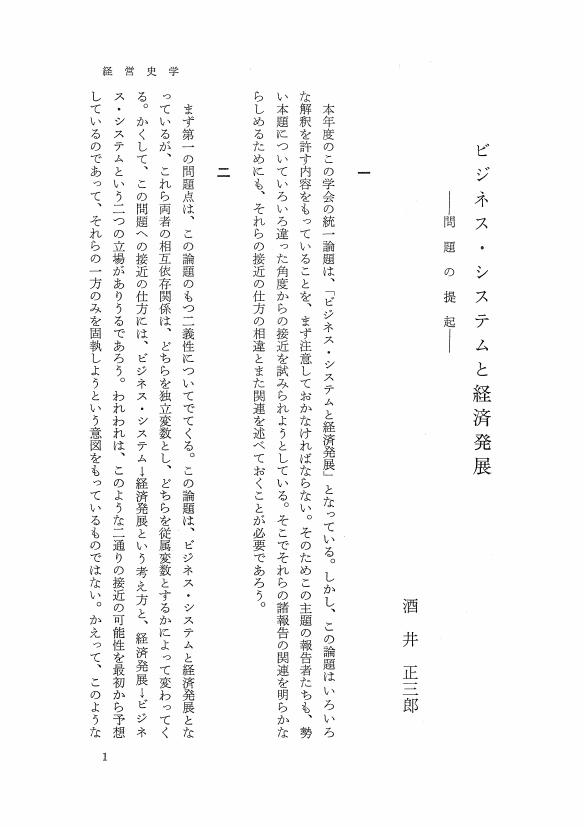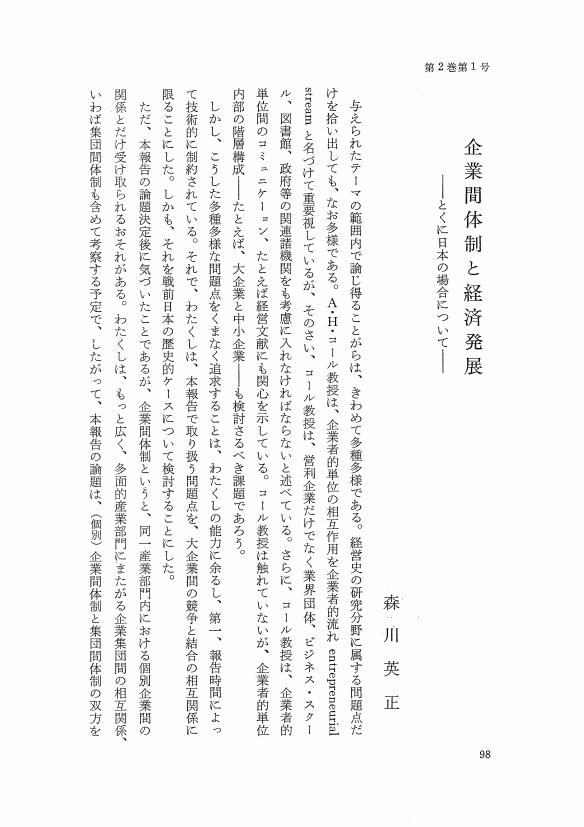- 著者
- 菅原 充
- 出版者
- 公益財団法人 日本学術協力財団
- 雑誌
- 学術の動向 (ISSN:13423363)
- 巻号頁・発行日
- vol.21, no.12, pp.12_74-12_78, 2016
1 0 0 0 OA コメント3
- 著者
- 荒井 政治
- 出版者
- 経営史学会
- 雑誌
- 経営史学 (ISSN:03869113)
- 巻号頁・発行日
- vol.2, no.1, pp.93-97, 1967-07-30 (Released:2009-11-11)
1 0 0 0 OA ビジネス・システムと経済発展 問題の提起
- 著者
- 酒井 正三郎
- 出版者
- 経営史学会
- 雑誌
- 経営史学 (ISSN:03869113)
- 巻号頁・発行日
- vol.2, no.1, pp.1-12, 1967-07-30 (Released:2009-11-11)
1 0 0 0 OA コメント4
- 著者
- 野口 祐
- 出版者
- 経営史学会
- 雑誌
- 経営史学 (ISSN:03869113)
- 巻号頁・発行日
- vol.2, no.1, pp.110-112, 1967-07-30 (Released:2009-11-11)
1 0 0 0 OA 日本経営史における「家」の問題
- 著者
- 堀江 保蔵
- 出版者
- 経営史学会
- 雑誌
- 経営史学 (ISSN:03869113)
- 巻号頁・発行日
- vol.2, no.1, pp.113-132, 1967-07-30 (Released:2009-11-11)
1 0 0 0 OA 作業現場における管理技術の展開
- 著者
- 土屋 守章
- 出版者
- 経営史学会
- 雑誌
- 経営史学 (ISSN:03869113)
- 巻号頁・発行日
- vol.2, no.1, pp.13-22, 1967-07-30 (Released:2009-11-11)
1 0 0 0 OA コメント1
- 著者
- 橘 博
- 出版者
- 経営史学会
- 雑誌
- 経営史学 (ISSN:03869113)
- 巻号頁・発行日
- vol.2, no.1, pp.22-26, 1967-07-30 (Released:2009-11-11)
1 0 0 0 OA 管理機構再編成の過程
- 著者
- 岡本 康雄
- 出版者
- 経営史学会
- 雑誌
- 経営史学 (ISSN:03869113)
- 巻号頁・発行日
- vol.2, no.1, pp.27-71, 1967-07-30 (Released:2009-11-11)
1 0 0 0 OA コメント2
- 著者
- 鳥羽 欽一郎
- 出版者
- 経営史学会
- 雑誌
- 経営史学 (ISSN:03869113)
- 巻号頁・発行日
- vol.2, no.1, pp.71-76, 1967-07-30 (Released:2009-11-11)
1 0 0 0 OA 株式会社制度と近代的経営の展開
- 著者
- 新保 博
- 出版者
- 経営史学会
- 雑誌
- 経営史学 (ISSN:03869113)
- 巻号頁・発行日
- vol.2, no.1, pp.77-93, 1967-07-30 (Released:2009-11-11)
1 0 0 0 OA 企業間体制と経済発展 とくに日本の場合について
- 著者
- 森川 英正
- 出版者
- 経営史学会
- 雑誌
- 経営史学 (ISSN:03869113)
- 巻号頁・発行日
- vol.2, no.1, pp.98-110, 1967-07-30 (Released:2009-11-11)
1 0 0 0 OA 清末洋務運動期の企業者活動 -官督商弁制度を中心に-
- 著者
- 楊 天溢
- 出版者
- 経営史学会
- 雑誌
- 経営史学 (ISSN:03869113)
- 巻号頁・発行日
- vol.1, no.3, pp.56-114,ii, 1966-12-20 (Released:2009-11-11)
This paper is a study of the bureaucratic entrepreneur in the system of Kuan-tu sang Pan (Official Supervision and Merchant Managelnent System : 官督商弁組織), using the China Merchants' Steam Navigation Co. and the Shanghai Cotton Cloth Mill as case studies. The industrialization effort in late Ch'ing China, in response to increasing pressure from the Occident, was directed by powerful provincial leaders, of whom Governor-general Li Hung-chang was an outstanding example. The efforts made to introduce new industries started also as an anti-revolutionary movement in response to the threat of the Great Taiping revolutionary agitation, and aimed at a reorganization of the feudal system under the Ch'ing Dynasty, which was more in line with the interests of the educated elite. Therefore, the self-strengthening ideology which they helped to fashion sought to meet the challenge of both the Occident and the peasant. The introduction of modern industrial and commercial enterprise was the instrument (用) by which the essence (体) of traditional, Confucian, agrarian China was to be preserved. Accordingly, the Kuan-tu sang-pan system they devised, which set the model for the earliest modern industrial enterprise in China, was in effect a compromise between the urgent need for modernization and the conservatism of the traditional society. The system was not intended to subvert the old order, nor did it represent to its patrons an effort to remake the fundamental bases of the traditional society.The Kuan-tu sang-pan pattern was also deliberately designed to tap the new source of compradore capital which had developed in the treaty ports after 1842, and the share capital of these enterprises came largely from treaty-port merchants. Although the Kuan-tu sang-pan firms were joint official-merchant undertakings, the officials sought to regulate operations and keep them within their complete control by means of their great political weight in the traditional bureaucratic system; in general terms, merchant management was to be guided by official supervision. In the Kuan-tu sang-pan formula an appointee of the firm's promoter was the supervising official; although the position of the merchant manager was ambiguous, he usually held official rank and was also a representative of the shareholders. The management of these enterprises was characterized by their traditional practices, bureaucratic motivation, and corruption. It was deficient in the rationalized organization, functional specialization, and impersonal discipline associated with the development of modern industry in the West.The China Merchants' Steam Navigation Co. was established in an effort to compete with the foreign shipping, mainly British, which was dominating trade in Chinese waters. The establishment of the Shanghai Cotton Cloth Mill was the first attempt to establish a Chinese-owned factory to manufacture cotton goods in competition with the huge, and growing, flood of imports from the mills of Lancashire and America. The history of these firms illustrates the incompetence of bureaucratic management and the characteristic features of modern enterprise in China.
1 0 0 0 OA ヒルシュマイア『明治日本の企業者精神について』
- 著者
- 由井 常彦
- 出版者
- 経営史学会
- 雑誌
- 経営史学 (ISSN:03869113)
- 巻号頁・発行日
- vol.1, no.2, pp.88-106, 1966-09-30 (Released:2009-11-11)
1 0 0 0 OA 小野権右衛門家と南部「郡印」の経営 小野組前史の研究
- 著者
- 宮本 又次
- 出版者
- 経営史学会
- 雑誌
- 経営史学 (ISSN:03869113)
- 巻号頁・発行日
- vol.1, no.2, pp.43-87, 1966-09-30 (Released:2009-11-11)
- 参考文献数
- 48
This paper is concerned with the management organization of the Ono Gonemon family, descendants of the house of Ono Zensuke. The Ono Gonemon house was known by the name Kagiya in Kyoto and Izustuya in Nambu Koriyama. In Kyoto the family engaged in the trade of products from northern Japan, and acted as pawn brokers and second-hand dealers. They possessed a kabu license for waste paper and were active in second-hand trade as well as other businesses. In Nambu the family was involved in sake brewing, pawn brokerage, and money exchange, and served the han government in each of these occupations. In the present paper, house lineage, house precepts, and store rules are introduced, the management structure of the Nambu store and its relations with Kyoto are examined in detail, and business conditions and the organization of bekke branch families are also discussed. The management of commodities, organization of account books, accumulation of property, and sake brewing will be discussed in a subsequent article.
1 0 0 0 OA アメリカにおける「管理の科学」形成の基盤
- 著者
- 土屋 守章
- 出版者
- 経営史学会
- 雑誌
- 経営史学 (ISSN:03869113)
- 巻号頁・発行日
- vol.1, no.2, pp.1-24, 1966-09-30 (Released:2009-11-11)
- 参考文献数
- 46
Conscious efforts to form a science of management were initiated in the United States in the late nineteenth century. This paper will inquire into the general conditions in which a scientific approach to management problems and the efforts to form a science of management were developed. The conditions might prescribe the essential character of the science of management in its early stages.The possibility of a science of management was primarily perceived by H. Metcalfe and H. R. Towne in the 1880's. Thereafter many authors, mainly mechanical engineers, discussed management problems, but their interest was limited to the workshop. Therefore, the basic conditions for the birth of the new science of management might be thought to be in the workshop on which the top business managers focused their attention.However, the top-managers of the emerging big businesses in the Middle West were not directly interested in the workshop, but in the creation of national marketing networks or the horizontal combination. The original unit in the formation of a science of management was the eastern metal-working industries which supplied parts or machine tools to big businesses in the middle West.Cost reduction by the improvement of efficiency was the most important problem in the workshops of the eastern metal-working industries owners had abolished the sub-contracting system and directly controlled the workmen.At the same time, metal-working factories had become increasingly specialized in the product they were manufacturing. Such specialization made it possible to achieve fairly complex division of labor and, as result, the work of a laborer could be measured objectively.These were the particular conditions in the eastern machine shops from which the science of management emerged.
1 0 0 0 OA 産業革命期イギリスの工業における固定資本概念
- 著者
- 大河内 暁男
- 出版者
- 経営史学会
- 雑誌
- 経営史学 (ISSN:03869113)
- 巻号頁・発行日
- vol.1, no.2, pp.25-42, 1966-09-30 (Released:2009-11-11)
- 参考文献数
- 21
Fixed Capital in most of the manufacturing industries increased remarkably as a result of the industrial revolution. Research in the history of accounting indicates, however, that modern accounting methods, including depreciation and cost accounting to deal with the increased fixed capital, were gradually developed in the late nineteenth century. During the more than fifty year time lag, how was fixed capital treated in the accounting of the manufacturing business ; what delayed the appearance of industrial book-keeping?One important premise to remember is that during the eighteenth and nineteenth centuries lease of the workshop, including machines and other equipment was quite common in England. Industrialists could, by leasing, be relieved of the burden of heavy investment for fixed capital. Accordingly, their only interest in regard to fixed capital was the amount of rent, and they did not recognize the depreciation of the shops and equipment leased. This fact seems to be one of the main reasons why modern industrial accounting was delayed until the latter half of the nineteenth century.Before the end of the eighteenth century, however, some of the larger and leading enterprises had their own workshops and equipment. In such cases, they had to be aware of the annual depreciation of their own invested capital and the accounting of costs, which included transference of the depreciated capital value.For example, Samuel Oldknow, a famous muslin manufacture, recognized the transference of the fixed capital value to the value of his products ; but he did not list the depreciation. The annual decrease in value, or depreciation of the fixed capital, was clearly recognized in the trading account of the Soho Engine Manufactory, managed by Boulton and Watt, but they were hardly concerned about the transference.Thus, during the industrial revolution, the basic ideas about fixed capital had already begun to appear ; but so long as the lease of workshops was widespread, the concept of the fixed capital could not be generally recognized.
1 0 0 0 OA 個別企業史はいかに研究すべきか コメント/討論
- 著者
- 藤津 清治
- 出版者
- 経営史学会
- 雑誌
- 経営史学 (ISSN:03869113)
- 巻号頁・発行日
- vol.1, no.1, pp.104-108, 1966-06-20 (Released:2009-11-11)
1 0 0 0 OA 「文化構造」と経営史 コメント/討論
- 著者
- 由井 常彦
- 出版者
- 経営史学会
- 雑誌
- 経営史学 (ISSN:03869113)
- 巻号頁・発行日
- vol.1, no.1, pp.25-31, 1966-06-20 (Released:2009-11-11)
- 被引用文献数
- 1
1 0 0 0 OA 経営主体の諸概念
- 著者
- 桂 芳男
- 出版者
- 経営史学会
- 雑誌
- 経営史学 (ISSN:03869113)
- 巻号頁・発行日
- vol.1, no.1, pp.71-89, 1966-06-20 (Released:2009-11-11)
1 0 0 0 OA 「文化構造」と経営史 行為理論による企業者研究
- 著者
- 間 宏
- 出版者
- 経営史学会
- 雑誌
- 経営史学 (ISSN:03869113)
- 巻号頁・発行日
- vol.1, no.1, pp.13-25, 1966-06-20 (Released:2009-11-11)














